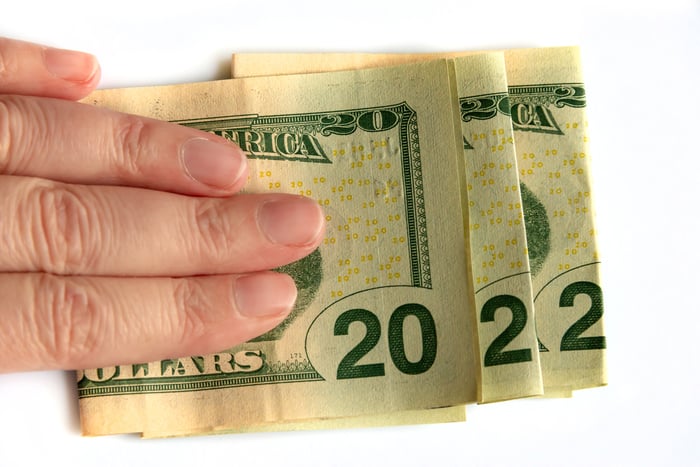In less than 48 hours, we'll be ringing in the new year. However, Wall Street might be sad to the see the page turn. After all, the benchmark S&P 500 has more than doubled up its average annual total return of 11% since the beginning of 1980, through this past weekend.
As for me, I'm looking forward to 2022. Despite the gains in the S&P 500, it was a rough year for many of my largest holdings. Nevertheless, I'll be counting on these five top portfolio holdings to continue to make me richer over the long haul.

Image source: Getty Images.
SSR Mining
Gold stock SSR Mining (SSRM 2.98%) has been my largest holding for some time. I initially owned shares of Canadian gold miner Claude Resources, which SSR acquired in a cash-and-stock deal in 2016.
To own gold-mining stocks you need to believe two things. First, you'll need to believe the price of physical gold is going to head higher. With the Federal Reserve vastly increasing the money supply over the past decade, inflation hitting a 39-year high in the U.S. in November, and bond yields remaining near record lows, gold looks as lustrous as ever.
The other belief that's necessary if you're going to own a gold-mining stock is that the company you own can sustain or increase production while maintaining a healthy balance sheet. SSR Mining is arguably the best value in the industry.
In 2020, it completed a merger of equals with Turkey's Alacer Gold. Bringing Alacer into the fold nearly doubled SSR's annual output. Management anticipates the company will produce 700,000 gold equivalent ounces (GEO) to 800,000 GEO on an annual basis for at least the next five years.
Furthermore, whereas most mining stocks are still trying to work their way out of net debt positions, SSR is sporting more than $500 million in net cash, has introduced a $0.05 per quarter dividend, and approved a $150 million share repurchase program.
The bottom line is that gold stocks are, in my view, fairly valued at 10 times cash flow. SSR Mining can currently be bought for a little over six times Wall Street's estimated cash flow per share in 2022.

Image source: Getty Images.
Teva Pharmaceutical Industries
My second-largest holding at the moment is brand-name and generic drug company Teva Pharmaceutical Industries (TEVA 1.01%). Teva has been a continuous holding in my portfolio for over four years, but I've made plenty of purchases along the way.
I'd be lying to you if I said everything has been great with Teva. The company has navigated its way through five really rough years. It's settled bribery allegations, nixed its dividend, grossly overpaid for generic-drug company Actavis, and is facing litigation galore over its alleged role in the opioid crisis. The latter has been the gray cloud that's really held Teva back throughout 2021.
But buying into turnaround stories has always been the itch I love to scratch -- and I see Teva as a turnaround story that's going to eventually shine.
The most important thing for Teva is keeping CEO Kare Schultz at the helm. Schultz is a turnaround specialist who was hired a little over four years ago. Since taking over, he's helped slash expenses by the billions, sold non-core assets, and reduced the company's net debt from north of $34 billion to $22 billion.
Schultz is also likely to play a key role in helping to resolve Teva's legal woes. With cash at a premium for a company focused on paying down its debt, Schultz may be able to broker a large-scale deal to offer free or reduced-cost medicine.
What's more, Teva won an opioid trial in California in early November, which signifies that the company's liability may not be anywhere near as high as Wall Street had feared. With Teva shares going for a bargain-basement three times forward earnings, I foresee brighter days ahead.

Image source: Getty Images.
First Majestic Silver
Yes, another mining stock! My third-largest holding is First Majestic Silver (AG 4.12%), which, as its name plainly suggests, generates most of its revenue from producing silver (and to a lesser extent gold). I was a previous shareholder of Primero Mining, which was acquired at a hearty premium by First Majestic Silver in 2018.
The same premise holds true with silver stocks as it does with gold-mining companies (i.e., I do believe the price of silver will increase over time). Growing demand for silver in electric vehicles and solar panels represents just some of the key demand-side opportunities that should drive prices higher for silver over the long term.
First Majestic Silver currently has four producing assets, along with an equal number of projects that are being developed or waiting in the wings until silver prices make them economically viable. The San Dimas mine, which is what was acquired in the Primero deal, continues to be a shining star. This year, it's expected to have produced between 7.6 million silver equivalent ounces (SEO) and 8.1 million SEO at an all-in sustaining cost of a little over $12 per SEO. With spot silver at close to $23/ounce, San Dimas is generating substantial margins for the company.
First Majestic also recently acquired the Jerritt Canyon mine in the U.S., which lifted its gold exposure. The company will likely recognize around 75,000 gold ounces from seven months of operating Jerritt Canyon in 2021, but could see full-year production balloon to 200,000 gold ounces by 2024.
Although I unloaded close to 40% of my stake in First Majestic Silver during its early year short squeeze, I still foresee ample upside.

Image source: Getty Images.
Bank of America
The longest-tenured stock in my portfolio, and the fourth-largest holding, is Bank of America (BAC 1.70%). My initial buy came a little over 10 years ago, and I've built up my position through a dividend reinvestment plan.
Without question, the most exciting development for Bank of America is rapidly rising inflation. While that's not great news for consumers or businesses, higher inflation will encourage the Federal Reserve to act quicker and raise lending rates. No bank stock is more interest-sensitive than BofA.
According to the company, a 100-basis-point parallel shift in the interest rate yield curve would add an estimated $7.2 billion in net interest income over 12 months. With Fed dot plots suggesting we could see up to 175 basis points in rate hikes through 2023, Bank of America could be on the verge of a big uptick in profits.
But I'm not just hanging on to BofA because interest rates are likely going up. Another reason I own Bank of America is because it's cyclical. Even though recessions are inevitable, they often last just a few months or a couple of quarters. Comparatively, periods of economic expansion are measured in years. This gives companies like BofA plenty of time to make loans and grow deposits (i.e., the bread and butter of banking).
The company also deserves credit for an effective digital banking shift. Nearly 5 million more people are banking digitally with BofA than at this time three years ago, with 43% of all sales being completed online or via mobile app in the third quarter. Digital sales are considerably cheaper for BofA, which has allowed the company to consolidate some of its branches.

Image source: Getty Images.
Bark
The only true newcomer to my top five portfolio holdings for the upcoming year is dog-focused products and services company Bark (BARK 1.82%).
While the pet industry isn't the fastest growing, it's proved to be virtually recession-proof. Data from the American Pet Products Association shows that year-over-year U.S. pet expenditures haven't declined in at least a quarter of a century. Additionally, pet ownership has hit a new high in the wake of the pandemic. In other words, people treat their furry, scaled, feathered, and gilled pets as family, and often spend a fortune to ensure their happiness and well-being.
What excites me so much about Bark is the company's operating model and innovation.
In terms of the former, Bark generates close to 90% of its revenue from online subscriptions. Though it does have a presence in roughly 23,000 retail doors, focusing on online subscriptions results in high margins, predictable cash flow, and less overhead. Bark has pretty consistently produced a gross margin around 60%.
There's also innovation in the form of newly launched products and services. In particular, Bark Home is a source to add on basic accessories like collars and beds, while Bark Eats will work with owners to develop a dry food diet specific to their pooch.
Bark has all the makings of a company that can triple its sales by mid-decade and possibly 10X my money by 2030.





